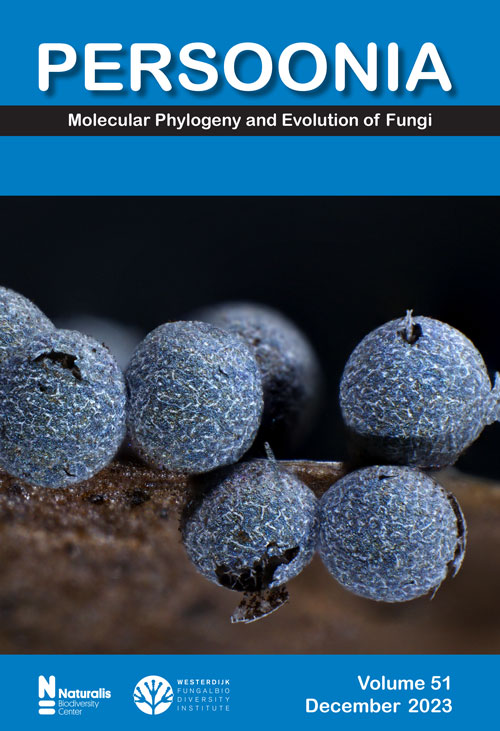中国柑橘病害相关 Diaporthe 的物种多样性较高
IF 7.3
1区 生物学
Q1 MYCOLOGY
引用次数: 0
摘要
Diaporthe 物种的寄主范围很广,分布于世界各地,以内生菌、汁菌和植物病原体的形式出现。以前的研究表明,许多 Diaporthe 物种与柑橘相关。为进一步确定中国柑橘病害相关 Diaporthe 物种的多样性,我们于 2017-2020 年在柑橘主产区进行了广泛调查。我们从叶片、果实、树枝、枝条和树干中采集了病组织,这些病组织表现出一系列症状,包括黑斑病、枯死病、胶冻病、木质部腐烂病和腐烂病。根据内部转录间隔区(ITS)、钙调蛋白(cal)、组蛋白H3(his3)、翻译伸长因子1-α(tef1)和β-微管蛋白(tub2)的DNA序列的系统发育比较,从10个省的393个分离物中鉴定出属于36个Diaporthe种,包括32个已知种,即D.apiculata、D. biconispora、D. biguttulata、D. caryae、D. citri、D. citriasiana、D. compacta、D. discoidispora、D.endophytica, D. eres, D. fusicola, D. fulvicolor, D. guangxiensis, D. hongkongensis, D. hubeiensis, D. limonicola, D. litchii, D. novem, D. passifloricola, D. penetriteum, D. pescicola, D. pometiae, D. sackstonii, D. sennicola, D. so.sennicola、D. sojae、D. spinosa、D. subclavata、D. tectonae、D. tibetensis、D. unshiuensis、D. velutina 和 D. xishuangbanica,以及 4 个新种,即 D. gammata、D. jishouensis、D. ruiliensis 和 D. sexualispora。在 32 个已知种中,14 个是首次在柑橘上报道,2 个是中国新报道。在这 36 个种中,柑橘褐斑病菌是优势种,这体现在它的高分离频率和高致病力上。致病性测试表明,本研究中获得的大多数 Diaporthe 物种对受测柑橘品种的侵染性较弱或无致病性。只有 D. citri 在柑橘嫩枝上产生的病斑长度最长,并在柑橘叶片上诱发黑色素。这些结果进一步表明,柑橘上的 Diaporthe 种类丰富多样,但只有少数几个种类是有害的,而 D. citri 是中国柑橘的主要病原菌。本研究为制定有针对性的监测、预防和控制措施提供了依据。本文章由计算机程序翻译,如有差异,请以英文原文为准。
High species diversity in Diaporthe associated with citrus diseases in China
Species in Diaporthe have broad host ranges and cosmopolitan geographic distributions, occurring as endophytes, saprobes and plantpathogens. Previous studies have indicated that many Diaporthe species are associated with Citrus. To further determine the diversity
of Diaporthe species associated with citrus diseases in China, we conducted extensive surveys in major citrus-producing are as from 2017–2020. Diseased tissues we recollected from leaves, fruits, twigs, branches and trunks showing a range of symptoms including melanose, dieback,
gummosis, wood decay and canker. Based on phylogenetic comparisons of DNA sequences of the internal transcribed spacer regions(ITS), calmodulin(cal), histoneH3(his3), translation elongation factor1-alpha (tef1) and beta-tubulin (tub2), 393 isolates from 10 provinces
were identified as belonging to 36 species of Diaporthe, including 32 known species, namely D. apiculata, D. biconispora, D. biguttulata, D. caryae, D. citri, D. citriasiana, D. compacta, D. discoidispora, D. endophytica, D. eres, D. fusicola, D. fulvicolor, D. guangxiensis, D. hongkongensis, D. hubeiensis, D. limonicola, D. litchii, D. novem, D. passifloricola, D. penetriteum, D. pescicola, D. pometiae, D. sackstonii, D. sennicola, D. sojae, D. spinosa, D. subclavata, D. tectonae, D. tibetensis, D. unshiuensis, D. velutina and D. xishuangbanica, and four new species, namely D. gammata , D. jishouensis, D. ruiliensis and D. sexualispora. Among the 32 known species, 14 are reported for the first time on Citrus, and two are newly reported from China. Among the 36 species, D. citri was the dominant species as exemplified by its high frequency of isolationand virulence. Pathogenicity
tests indicated that most Diaporthe species obtained in this study were weakly aggressive or non-pathogenic to the tested citrus varieties. Only D. citri produced the longest lesion lengths on citrus shoots and induced melanose on citrus leaves. These results further demonstrated
that a rich diversity of Diaporthe species occupy Citrus, but only a few species are harmful and D. citri is the main pathogen for Citrus in China. The present study provides a basis from which targeted monitoring, prevention and control measures can be developed.
求助全文
通过发布文献求助,成功后即可免费获取论文全文。
去求助
来源期刊

Persoonia
MYCOLOGY-
CiteScore
17.70
自引率
5.50%
发文量
10
审稿时长
3 months
期刊介绍:
Persoonia aspires to publish papers focusing on the molecular systematics and evolution of fungi. Additionally, it seeks to advance fungal taxonomy by employing a polythetic approach to elucidate the genuine phylogeny and relationships within the kingdom Fungi. The journal is dedicated to disseminating high-quality papers that unravel both known and novel fungal taxa at the DNA level. Moreover, it endeavors to provide fresh insights into evolutionary processes and relationships. The scope of papers considered encompasses research articles, along with topical and book reviews.
 求助内容:
求助内容: 应助结果提醒方式:
应助结果提醒方式:


